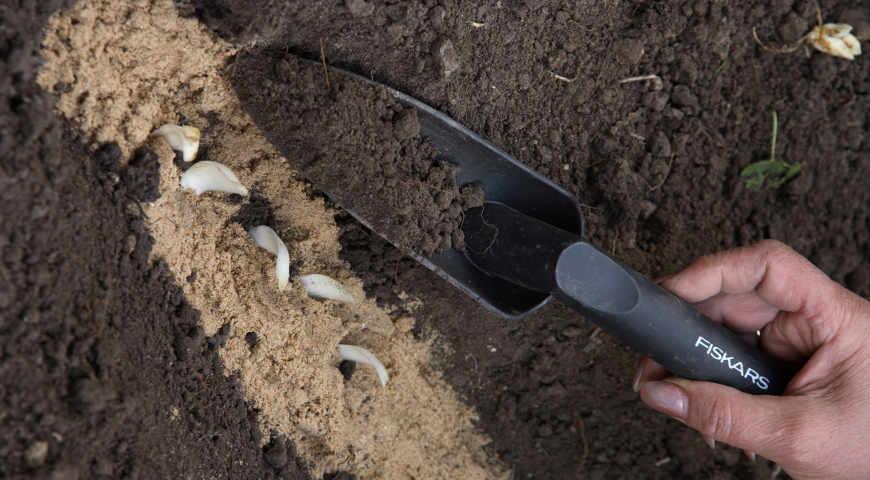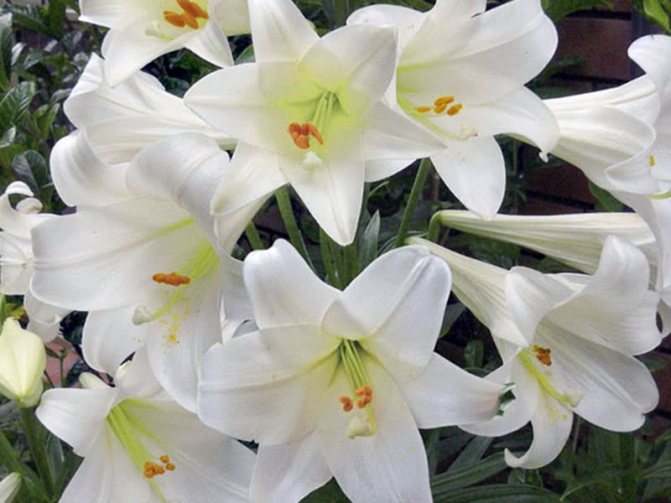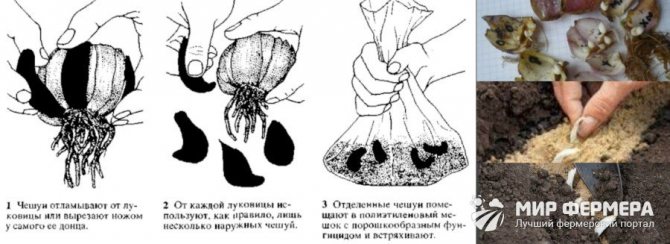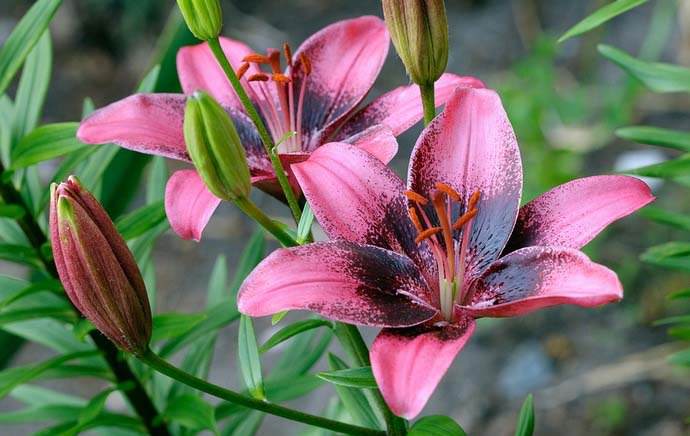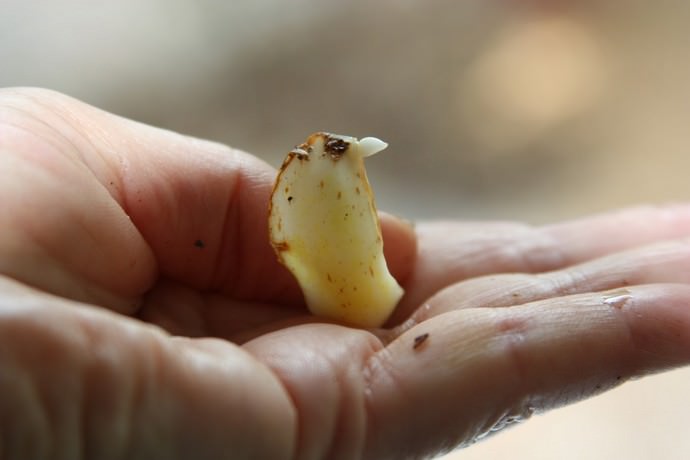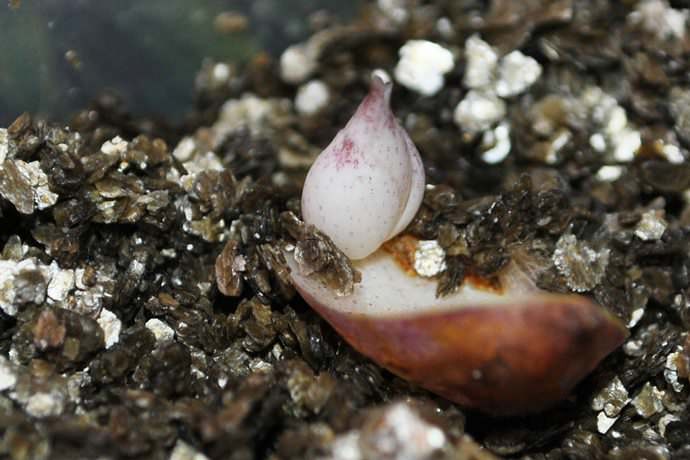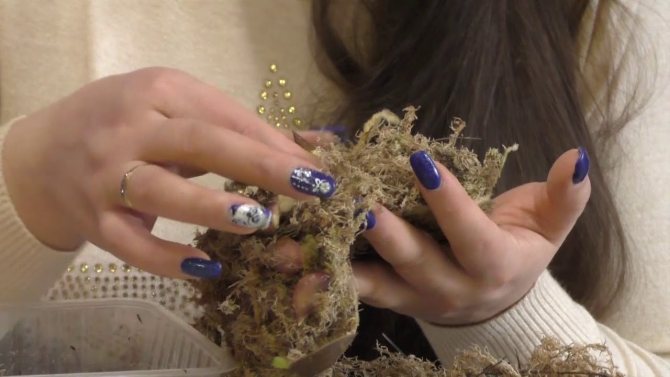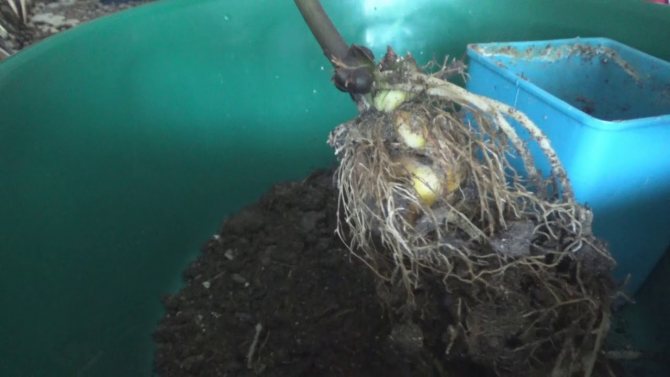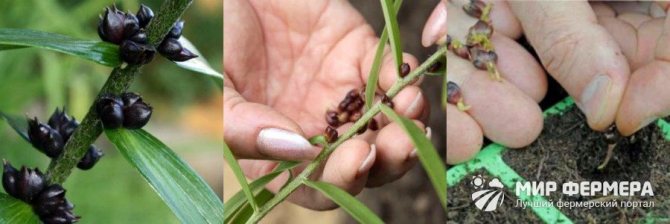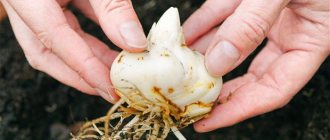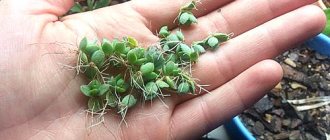Lilies are fairly easy-to-care plants that tolerate various climatic conditions well. They can grow in any soil with sufficient moisture. In this regard, it is possible to grow flowers in the open ground in summer cottages, in containers, pots and greenhouses. Self-propagating lilies at home is an economical way to increase the number of flowers at no additional cost. To successfully breed Liliaceae, you need to take into account several important nuances regarding the structure of flowers and their ability to quickly adapt and develop.
Home breeding methods for lilies
Novice growers often ask how to properly propagate lilies and which method gives the best result. There are several breeding methods, and to understand the advantages and disadvantages of specific methods and their effectiveness in relation to a particular variety, it is worth studying each of them:
- reproduction by daughter bulbs;
- division of the nest;
- growing by seeds;
- obtaining new bulbs from scales;
- by grafting;
- with the help of air bulbs.
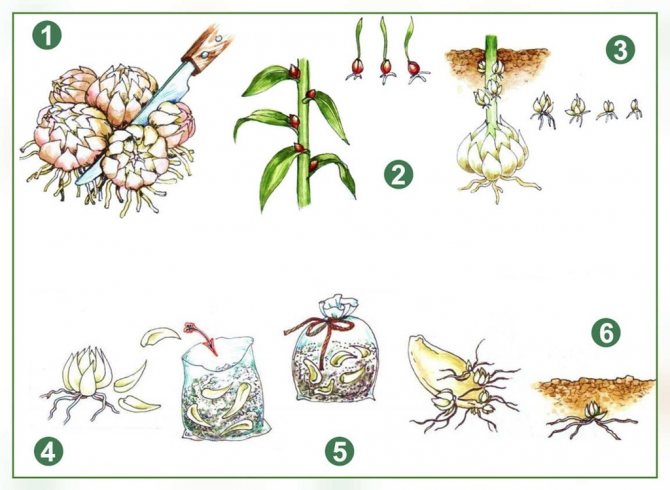
Breeding methods for lilies
It is not easy to single out the only universal and most effective method, since they all differ in the level of complexity, germination duration and applicability to different types of lilies. However, the undoubted advantage of any method is the ability to preserve the variety in its original form. Breeding success will depend not only on the skill of the growers, but also on factors such as the quality, health and age of the mother plant.
It will also be interesting: When to transplant lilies - after flowering, to another place, in autumn or spring ⚜
Breeding method by dividing the bush
Suitable for beginners, as it is very easy and affordable. About once every three to four seasons, several small bulbs form in the bulbous nest. Carefully count the number of stems, the same number of bulbs formed. In the fall or late summer, carefully pick up a lily bush with a pitchfork and divide it into several individual bulbs. Drop each one in a prearranged location. If you manage not to damage the bulbs, then they will bloom next summer. The method of dividing the bush is not suitable for every variety of lilies, because, for example, Tubular and Oriental hybrids either do not produce small bulbs, or there are very few of them.
How to propagate a lily with daughter bulbs
Daughter bulbs (babies) form in the leaf axils of adult bulbs. Their main function is vegetative propagation of the plant. Children not only can, but also need to be separated from the mother's bulb in order to prevent it from weakening.
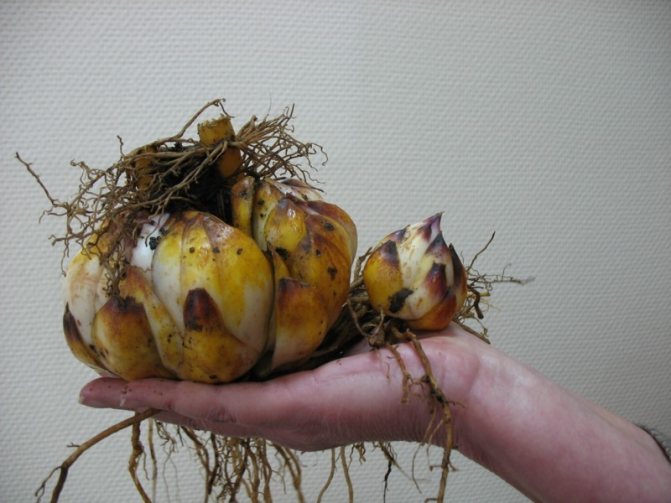

The advantages of this method are the low probability of harming the plant and the ease of separating the children.
There are two ways to separate the bulbs:
- Dig up the onion. Often this method is used in case of a necessary transplantation of the mother's bulb. Babies that are ready for planting often fall away from the bulb by themselves.
- Leave the bulb in the ground. Using this method, you can get children by shoveling the earth from the bulb and gradually removing the children.
An important point to remember before boarding is the examination of the children. Some may be blotchy or sore.In this case, you need to get rid of them, but you cannot throw them into compost, as children can become a source of illness.
So, for the reproduction of lilies in this way, you need to separate the children from the mother's bulb with your hands, if they have not disappeared themselves. Then they should be cleaned of red scales and rinsed in water. Then soak for 20 minutes in a weak manganese solution and let dry on its own. While they are drying, prepare a bed with a light nutritious soil. Such land is suitable for growing children in the first two years, and then the plants can be transplanted to a permanent place.
When the bulbs are dry, you need to carefully trim their roots and plant them. The optimal time for planting is August or early September. This will give the plants time to grow stronger and prepare for winter. Plants propagated by this method bloom in the third or fourth year.
It will also be interesting: When to dig up lilies - for transplanting, after flowering and whether it is necessary ⚜
Lily description
The beautiful lily flower comes from the genus Liliaceae. Refers to perennial plants supplied with bulbs. Each onion consists of individual thick and fleshy lower leaves that are white with a pink or yellowish tinge. It hibernates in the soil and allows the plant to begin a new life cycle with the onset of spring.
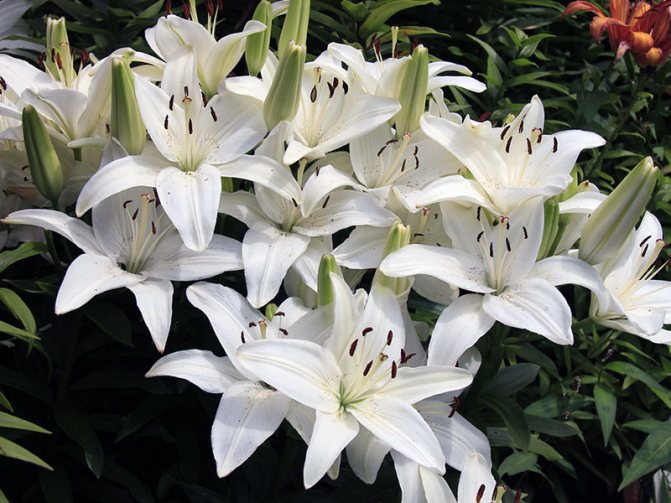

Lily
The lily stem is a continuation of the bottom of the bulb and looks simple, leafy and slightly branched at the top. This structure of the plant makes it possible to quite successfully propagate it in several ways.
Important! Leaf cuttings are present in only two types of bulbs. Most of the leaves are sessile, which also allows the lily to be cut and propagated with a green leaf.
In general, 9 ways are known how to grow a lily, each of which has the right to exist, especially when propagating expensive and rare varieties in the fall, where every opportunity to obtain planting material is used:
- division of the lily bush;
- reproduction by newly formed children;
- reproduction by bulbs that have grown at the base of the leaves;
- cuttings with stem cuttings;
- cuttings with young flower shoots;
- propagation of lilies by leaf cuttings;
- reproduction by separating the lower leaves from the bulb;
- reproduction by sowing ripe seeds;
- spring reproduction by dissecting the bottom.
Lilies are perennials with a delicate fine aroma and beautiful large flowers. They are also attractive to gardeners because they do not require digging and winter storage in basements or shelter for the winter. They may well bloom in one place for several years and do not require much care and worries. Only a few species of lilies are so thermophilic and not adapted for wintering that flower growers prefer to grow them indoors.
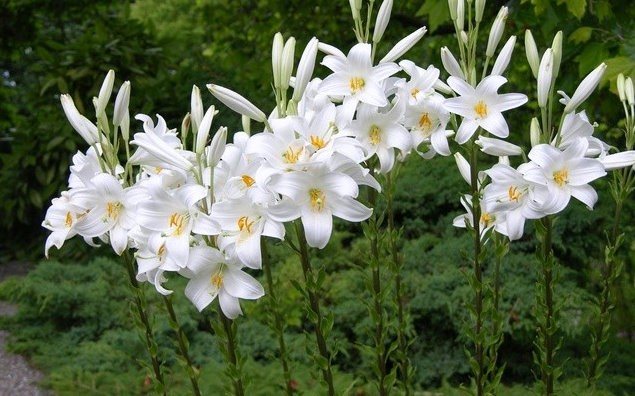

Lily
To get an adult that can bloom, the plant he has to grow the bulb for several years. Therefore, high-quality planting material is expensive and not everyone can afford to buy it, especially if a florist wants to get a large clump of plants of the same variety.
To get more planting material from one purchased bulb, it is worth learning how to cut lilies correctly, and use different methods to get a couple of dozen new young plants from one planted lily within one summer.
For your information! More than 6,000 varieties of lilies are known in the world at the moment, which are used to decorate rooms, winter gardens, greenhouses, gazebos and flower beds. A huge number of lilies in the world are grown on plantations to obtain raw materials for perfumery and cosmetic products, for cutting and making wonderful exquisite bouquets.
Lily nest division method
The nest is formed 3-4 years after planting the flower with the help of the mother or daughter bulbs, which develop new stems and root system.The division of the nest must be carried out when it has 4-6 bulbs. The best time for this procedure is one month after the lily blooms.
Division cannot be carried out immediately after the end of flowering, since the bulb can be emaciated and loose, and have withered scales. Weak bulbs will not be able to transfer the branches and will die. After a month, the lily will recover, become elastic and strong.
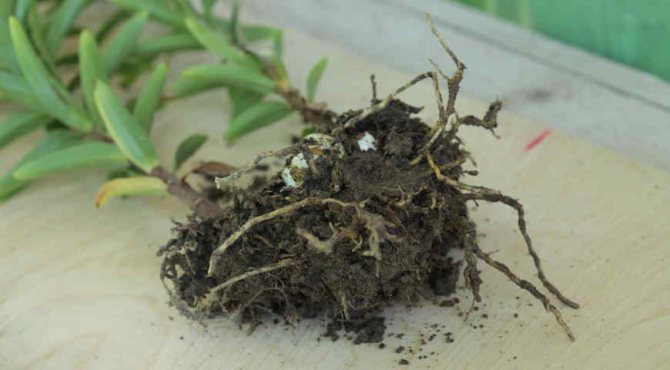

This recovery process can be influenced by regular, moderate watering and feeding.
The procedure for dividing a lily nest looks like this:
- The bush must be carefully dug out, avoiding damage to the roots and onions. If the roots have been damaged, the chance that the lily will not bloom is increased.
- Place the nest on the ground and start by separating the babies until there are a few large bulbs left, each with a stem.
- The stems need to be cut off with a secateurs, leaving only the stump.
- The roots should be freed from the earthy coma and divided into separate onions.
- If there are dead or damaged roots, they must be cut off. In this case, the length of the remaining healthy roots should be no more than 15 cm.
Healthy bulbs (both maternal and child) should be white and pink, free from spots and defects. Lilies should be planted in early autumn, in fertilized light soil that allows air to pass through well. When planting, the distance between the holes should be observed to provide enough space for the root system of each flower. Lily will bloom in the second or third year with regular feeding and careful care.
It will also be interesting: Planting lilies in the fall - when and how to transplant a flower to another place and in what month ⚜
Division with the help of children
This method is similar to dividing a bush, but differs in that you need to divide the bulbs located on the underground parts of the stems. Also, in the fall, a bush is carefully dug up and examined for the presence of small bulbs, each of which can be planted as an independent plant. Interestingly, dozens of these bulbs can be produced in Asian hybrid lilies. They are not yet quite strong to bloom next summer, but in a year - for sure! The baby bulbs must also be separated from the main stem and planted in a separately prepared bed (no deeper than 3 cm), well covered from the winter cold with autumn leaves (straw is also suitable). Such bulbs will bloom after a year, and all this time it accumulates strength and develops. The next fall, already grown onions are planted in a columbarium, where in the next season the lilies will delight with lush flowers. It is important to know what to do if small buds have formed. They must be removed, then all the food will go to the bulb and root system. Only then will the bulbs develop properly. Most likely, beginners will have a question: what to do with the onion mother? She will not suffer at all and will safely give flowers more than once, therefore, after the children are separated, she is settled in a columbarium or other special place. This method is suitable for Canadian, Golden, Long-flowered, Tiger, Leopard varieties.
Features of growing lilies from seeds
After flowering, seeds are formed in capsules, which, as can be seen in the photo, burst after ripening. Seed propagation of lilies is the most laborious process. It will take longer than usual to wait for the lilies bred in this way to bloom. Before sowing seeds, you need to know the type of lily in order to determine which method of germination is characteristic of the flower: aboveground or underground. This will simplify further plant care.
Lily seeds quickly lose their germination, so they must be sown no later than two years after harvest. Before planting, it is recommended to treat the seeds with 1% hydrogen peroxide solution, and then soak them in water for 10-15 hours.
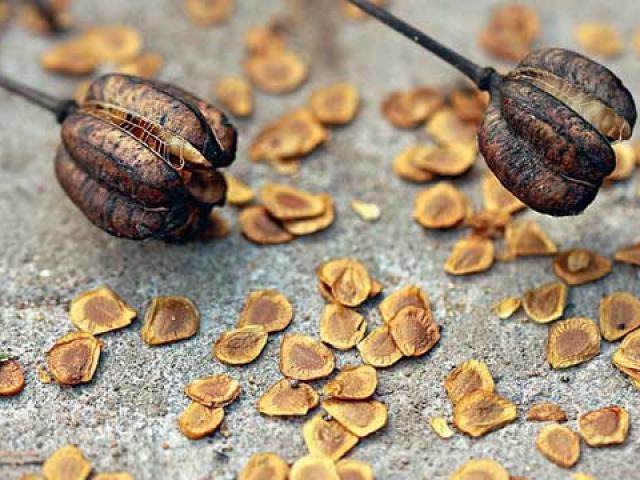

This procedure has a positive effect on the rate of seed germination and reduces the risk of future diseases.
Sowing seeds is carried out in late February or early March. To do this, use soil, which includes sand and leafy earth. The substrate for growing lilies can also include components such as:
- peat;
- humus;
- mineral fertilizers - nitrogen, potassium and phosphorus.
In order to grow a flower from seeds, you will need a wooden box or other container, the depth of which is at least 10 cm. You need to sow seeds into the soil to a depth of 0.5-1 cm, and then sprinkle with sand. After that, the container is covered with glass or polyethylene. The soil must be regularly moistened using a spray bottle with warm soft water, preventing the soil from drying out.
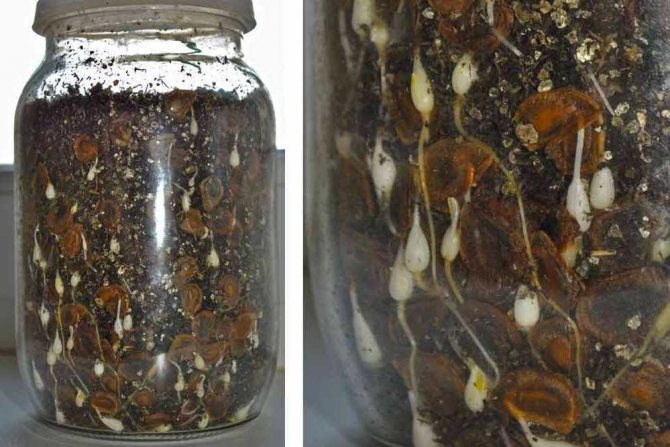

The container in which the seeds are located must be covered constantly, until the first shoots appear.
After that, you can remove the film for 2-4 hours a day, and when 3-4 sheets appear, remove it completely. During germination, the seedlings should be in a place with bright but diffused sunlight at a temperature of 15-20˚C. When the first leaves appear on the seedlings, they need to be planted in separate small pots with light soil. Maintenance should remain the same, but the soil should be loosened periodically.
Planting young plants in open ground takes place in late spring or early summer. When seating, you should maintain a distance of 30 cm between the holes. The planting site should be well lit, and the soil should be rich in trace elements. Frequent watering may be needed during summer. You need to loosen the ground carefully so as not to hurt the roots of the plant. It is possible to plant seedlings in open ground in late autumn, but in this case, the soil should be covered with needles or leaves, carefully warmed for the winter.
Lilies propagated by seeds are generally very viable and disease resistant compared to flowers grown with bulbs. Subject to all the rules for the care of the plants will be able to bloom next year.
How to breed your favorite lily specimen
If a novice florist liked a certain specimen of the garden queen, then you should not rush to buy the same species for breeding. You can get new bushes and create the perfect lily flower bed in four effective ways, namely:
- breeding lilies with scales;
- breeding lilies with bulbs;
- propagation of lilies by cuttings;
- seed reproduction of lilies.
All these methods of breeding lilies have their own specific characteristics and are used in different situations. But at the same time, most importantly, regardless of the chosen breeding method, all the above methods make it possible to increase the collection of the garden queen. And what is important, the new plants will fully retain all the characteristics of the mother plant.
We propagate the lily with scales
Reproduction of lilies by scales is the simplest and most common way, due to which, an increase in the number of plants will be successful. Moreover, this method can be used with all types of lilies. And a lush blooming flower can be obtained already in the second year after cultivation with scales. It is worth noting that literally from one mother bulb, it turns out, from 20 to 150 new young shoots. As for the selection of the time for breeding lilies with scales, experienced florists say that separation can be carried out at any time of the year, but autumn is still the most ideal. To do this, use purchased bulbs, or the material that was dug out before winter.


So, in order to propagate lilies with scales, it is necessary to complete several stages, namely:
- With the onset of autumn, the bulbs of the plant are dug up, thoroughly washed with warm water, and then carefully examined. The scales are separated from healthy bulbs, and any defective or diseased bulbs are removed;
- The prepared flakes are washed in warm water and immersed in a previously prepared weak solution of potassium permanganate for 20 minutes;
- Prepare the soil for planting scales in it, for this they take in equal parts forest moss, humus and black soil, then, pre-dried scales are placed in this mixture;
- The container in which the scales with soil are located is sealed with a bag on top and sent to a dark and warm place for a month. As a rule, after this period of time, new bulbs will begin to appear;
- When young bulbs are found, the container is transferred to a cool place and kept for another 1.5 months.
- When young bulbs undergo stratification, they begin to separate them. After this manipulation, they are first planted in the greenhouse, this time falls in February. And when May comes, the grown and strengthened roots are planted in a permanent place.
- If the method of reproduction of lilies in spring is chosen, then the young are immediately evicted into the garden, bypassing the greenhouse. As for the care of young growth, it is no different from adult flowers.
Reproduction of a garden queen with scales will take a total of about two years from the moment of separation from the main plant to the receipt of a full-grown adult flower.
IMPORTANT
To keep your own bulbs well in the winter, they should be thoroughly rinsed under water, and then dried and planted in wet sand, in which the bulb will be stored until spring.
Video "Reproduction of lilies by scales"
We propagate the garden queen with bulbs
Bulb propagation of lilies is another great way to get new shoots for planting. The so-called bulbous bulbs are formed in the leaves, which makes it possible to increase the number of any varieties of lilies.
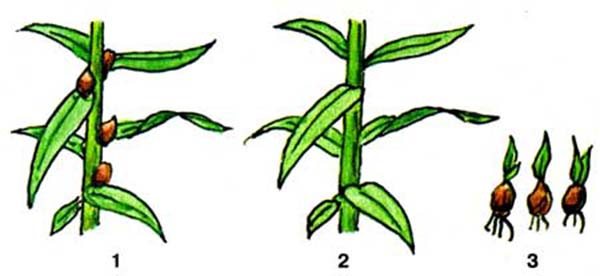

Lily propagation by bulbs
But at the same time, the success of this breeding method depends on many factors, namely:
- the younger the plant, the more planting material can be removed;
- the more abundantly the lily blooms, the more likely it is to get the desired bulbs;
- some varieties directly depend on weather conditions, to be more precise, the higher the humidity, the more bulbs are formed. Therefore, when buying planting material, this issue should be clarified with a consultant;
- if you resort to such manipulations as decapitation, then you can get bulbs even from those plants that practically do not bulb;
- bulbs are formed immediately after the plant has faded. And after their ripening, they begin to fall off, it is during this period that they should be collected.
Planting bulbs in the ground directly depends on the time of year. If it's warm outside, then the bulbs are immediately planted in the ground. Well, in the case when the cold season comes, then the reproduction of lilies in the fall is performed in a container. After planting, young bulbs need special care, they should be regularly moistened and maintained at a stable temperature.
Video "Reproduction of lilies by bubbly"
We propagate the lily by cuttings
This method of propagation by leaf (cuttings) is used when there are no seeds for planting or the garden queen does not have bulbs. For such purposes, sheets are selected from the top of the shoot and cut off. Then they are planted at an angle in pre-prepared containers, half filled with a mixture of soil and sand. Further care of cuttings requires regular moistening of the soil and storage of planting material away from direct sunlight.


Propagation of lilies by cuttings
With strict implementation of all recommendations, literally in a month the plants will delight with young bulbs. And with the onset of October, the young, along with the containers in which it is planted, are added dropwise to the flower garden, and carefully insulated from above.
This method is very successful as an alternative to scale breeding.Since this method does not require additional financial costs, and much effort is not required.
Growing lilies from seeds
Often, novice growers are interested in the question of how to get a beautiful lily plant from seeds growing in this way. First of all, propagation by this method is suitable for fast growing varieties. It is these types of garden queen that are capable of producing a large amount of seed.
Lily seeds
Planting seeds at home, begins at the end of February. For such purposes, it is necessary to first prepare a tray with nutrient soil and plant lily seeds into it to a depth of 1 cm.After the seed has been planted, the tray is sent to the windowsill, preferably from the southwest side.
In order to get seedlings, it is necessary to create good conditions, namely:
- in order for the sprouts to germinate, you need to constantly maintain room temperature; the sown seed material requires the creation of greenhouse conditions, therefore, the tray with seedlings is covered with foil;
- as soon as the first shoots become visible, the room temperature is lowered to 13 degrees and kept until the first leaf appears. Then the room temperature should be increased to 20 ° C heat;
- seedlings that have one or two leaves should be dived into a separate container with a depth of 10 cm;
- in order for the seedlings to develop well, it should be watered from a spray bottle, otherwise young shoots will die from excess moisture;
- with the onset of the end of April, the seedlings begin to harden, taking them out into the air for an hour, and then gradually increase the residence time of the sprouts.
When it comes time to plant the young in open ground, each sprout is carefully inspected and if weak flowers are identified, they are left to grow in the greenhouse until next spring. And those that are stronger go to the flower garden for planting at the end of May, to delight the grower.
IMPORTANT
Lilies do not tolerate direct rays of the sun, therefore, when choosing a site for a garden queen, they try to choose exactly the place where there will be a shadow for the damsel.
Getting lily bulbs from scales
Many daughter bulbs can be obtained by separating the scales. It is an economical and efficient breeding method suitable for varieties that produce small numbers of babies - Asiatic and Trumpet Lilies. Reproduction by scales can be carried out at any time of the year. There are two methods for harvesting flakes:
- Removing the bulb from the ground and subsequent manipulations:
- first rinse the bulbs and treat them with crushed coal;
- dip them in a manganese solution, and then treat them with a growth regulator;
- place the flakes in a plastic bag filled with substrate, moss or sawdust;
- close the bag and place it in a warm, dark place;
- the first bulbs appear after a month and a half at the base of the scales, they are separated and planted either in a suitable container for growing in autumn, or in open soil in spring and summer.
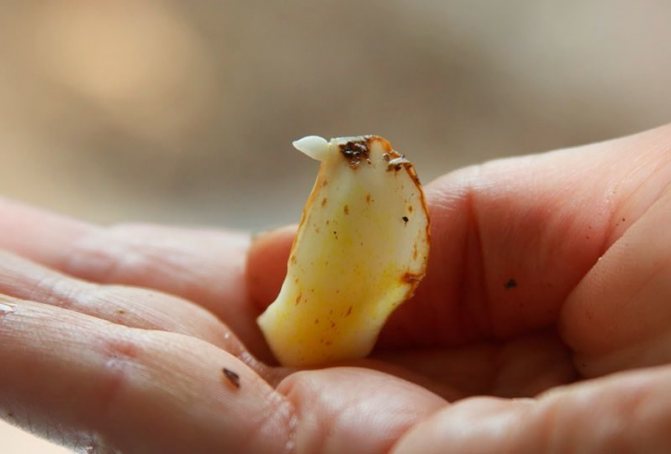

Reproduction of lilies by bulb scales
then no more than 1/3 of all the scales should be broken off from the base of the bulb;
- it is necessary to shake off the soil from the plant without damaging the roots;
carefully separate the required number of scales;
Reproduction of scales in this case is completely identical to the first method. It is necessary to plant bulbs propagated by scales to a depth of 2.5 cm, at a distance of 20 cm from each other. In this case, it is necessary that the tip protrudes slightly above the surface of the ground. Then the plants need to be sprinkled with sand, watered moderately, fertilized with peat and covered with dry leaves or foil.
It will also be interesting: How to feed lilies after flowering - in August and autumn ⚜
The third way - with scales of bulbs
We tie the bags with scales tightly and put them in storage in a dark place for 6-7 weeks. The temperature should be 22-23 ° C.
3-4 years after planting, a whole "nest" of 4-6 bulbs is formed underground, which we dig, divide and plant each bulb separately. The number of bulbs formed can be easily determined by the number of stems.
The plucked leaves are planted in containers with a nutrient substrate, deepening to half their length. It is imperative to make drainage holes in the planting tank and place a layer of gravel or expanded clay on the bottom. To maintain optimal humidity conditions, it is necessary to build a protective dome made of translucent material, which must be periodically removed for ventilation.
Among the flower bulbous crops, lilies are perhaps the most versatile in terms of use.
- The advantages of propagation with bulbs are that this method is effective, quite simple, non-traumatic for the plant, and in addition, it allows you to heal and rejuvenate lilies.
- Leaves,
- Stem cuttings
- 1 - stem cutting and its planting;
- Plant it and it will begin to develop and bloom normally.
- These bulbs form on the underground part of the stem. At the beginning of September, they must be separated without digging the mother's bulb, and immediately planted to a depth of 4-5 cm.It is still early for the children in the flower garden, so first it is better to plant them in a bed with light nutritious soil, and after a year or two, move them to a permanent place. In the meantime, there is no need to worry about it. ”
- See you soon, dear readers! In the meantime, there is no need to worry about it. ”
- After that, for another 4 weeks during storage, it is necessary to maintain a temperature of 17-18 ° C.
- The most optimal time for bulb propagation is autumn. But, if necessary, it is possible to carry out separation and transplantation in the spring. Just pay attention to the fact that the height of the plants in this case should be no more than 5-10 cm, otherwise they will not take root well.
- After 1 - 2 months, underground bulbs are formed at the base of the leaves, which even begin to germinate. It will be possible to transplant seedlings to a permanent place in the spring of next year, and for the winter it is recommended to keep the containers in a cool room (about 5 ° C).
In the genus Lilia, there are more than a hundred species that differ in growing conditions, flowering times, shape and color of flowers, which, in turn, makes this culture attractive for landscape design and gardening. Lilies look great when cut, some species are successfully grown in indoor culture. Some types of tubers are used in folk medicine and cooking.
Propagation of lilies by cuttings
Cuttings are suitable for varieties whose bulbs develop slowly, such as Tiger and White lilies. There are two ways of grafting:
- stem - the use of pieces of the stem;
- leafy - with the help of leaves.
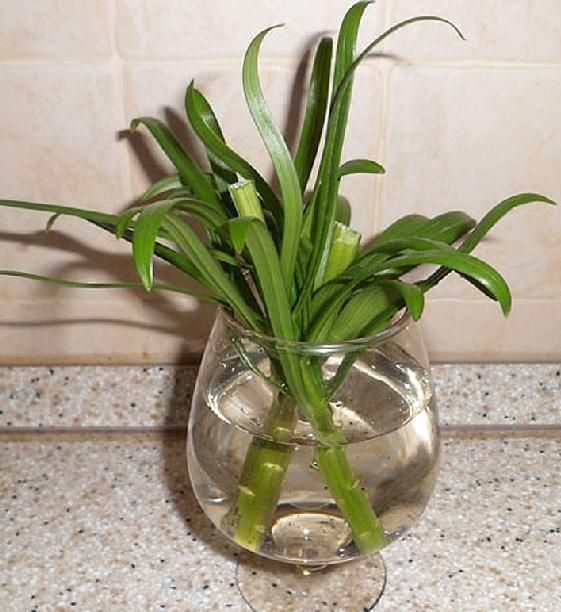

It is better to propagate a lily by cuttings in the period before budding, leaf propagation is possible before flowering.
Materials that will be needed to implement these methods:
- sand with humus;
- watering can;
- secateurs.
Stem cuttings
There are two types of cuttings that can be used for propagation:
- a whole stem, separated from the bulb;
- a section of a stem with a dormant bud.
Stem cutting involves the separation of a young flower shoot from the plant with a maximum length of 15 cm. The cut shoot must be treated with Kornevin, a preparation that stimulates the formation of roots and accelerates the rooting of cuttings. The shoot can be planted in drained nutrient soil and left to grow in a pot at home, or transplanted directly into the soil on the site under favorable weather conditions.
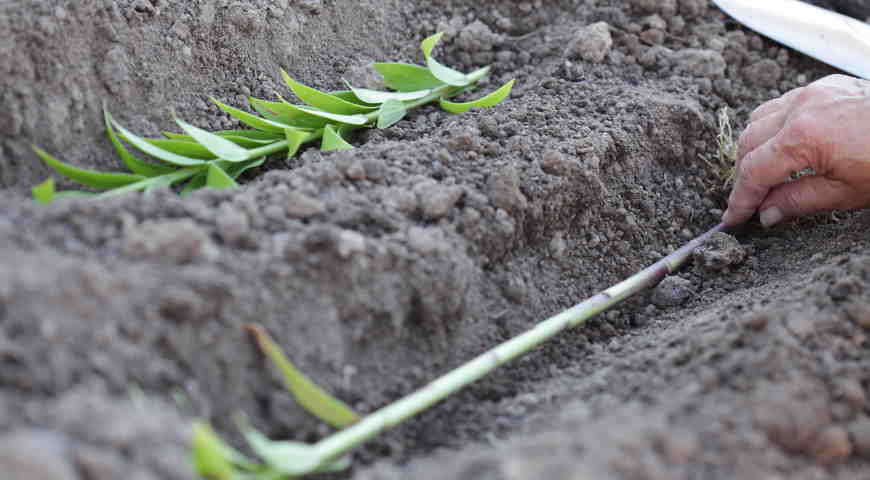

Stem cuttings are carried out in spring and summer.
Before planting the cuttings in open ground, 2-4 shallow cuts can be made on the stem, due to which the number of developing babies will increase.You need to plant the cutting in a shallow hole, and then sprinkle it with sand. The stem is then watered abundantly and covered with a jar or plastic bottle. This will create a greenhouse environment for the plant, thanks to which the cutting will take root faster.
Regular watering will help the shoot take root after 2 weeks, and after a short period of time, small bulbs will be visible at its base. As soon as this happens, the greenhouse can be cleaned, and the shoot can be spud to stimulate the growth of the bulbs. By August, the bulbs on the shoot can be separated and planted for growing. Plants propagated by stem cuttings bloom 1-2 years after planting.
Leaf cuttings
Cutting with leaves is used less frequently than other methods. Although this method shows a fairly high rate of survival, it requires experience. Suitable for varieties of Snow White, Tiger and Royal Lilies.
Leaf cuttings are actively carried out during the budding period before flowering. At this time, it is necessary to select and carefully pluck the strongest leaves together with their base and a piece of the stem. The leaves are planted in a container with large drainage holes and a layer of pebbles. Pour 10 cm of substrate and about 4 cm of sand onto the drainage.
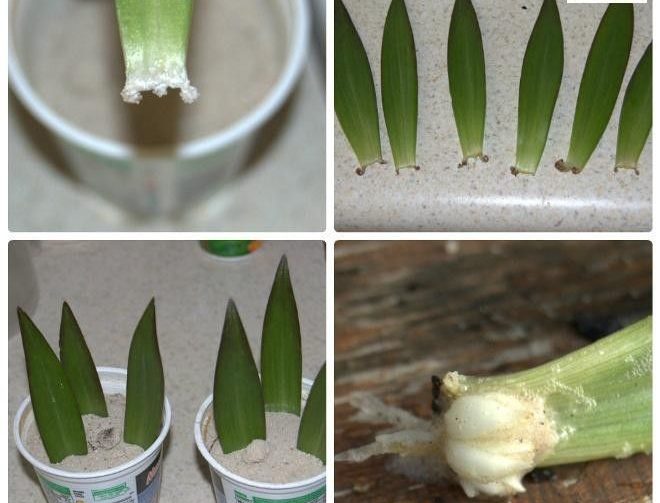

Leaf cuttings
The leaves are deepened into the pre-moistened soil at half their length; they must be laid with a slight slope. To ensure an optimal microclimate, the planting is covered with polyethylene, creating greenhouse conditions.
However, do not forget about regular airing of the planted leaves, regularly moisten the soil with soft, settled water and leave the container with plantings in a well-lit place. Subject to all the rules, the bulbs will form quickly, and in the spring they will be ready for planting in open ground.
Seeds at home
Seed propagation is acceptable for varietal lilies. Hybrids are not bred in this way. Full-value seeds are obtained from species of plants - Tibetan, Daurian, penetrating, one-color lily.
In open ground
Seeds are planted in the spring, preparing a bed for lilies. The soil should be nutritious and loose. Lilies grow best in open areas, not shaded by large trees. Flower seeds are laid in the grooves with a distance of 5 to 15 centimeters. Sprinkle on top with a moist substrate. In a month, sprouts will appear that require watering, loosening the soil. The lily develops from seeds for a long time, and will bloom only in the 4-5th year.
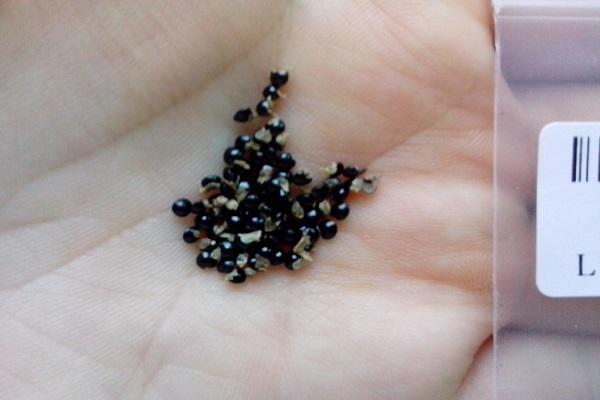

In seedling boxes
At home, sowing of ornamental culture begins from the end of February. Lily seeds are placed in boxes filled with nutritious soil. It is better to cover the planting with plastic wrap from above. Place containers in a warm place. The first shoots will appear in 30-35 days. Then the film is removed and the containers are placed on the windowsills, well lit, but not in direct sunlight. The seedlings are looked after, watering, feeding, diving in a timely manner. In May, the bulbs with sprouts are transferred to a permanent place.
In jars with a nutrient substrate
Lilies are sown in jars filled with a nutritious substance: moss, peat, vermiculite - the same as in boxes in February-March. Putting the container in a warm place, they are waiting for the sprouts to appear. Then containers with seedlings need a temperature of 15 degrees Celsius. The appearance of 2 true leaves suggests that the flower can be transplanted into separate containers.
See also
Description of the best varieties of tree lilies, planting and care in the open fieldRead
Plants are transferred to a permanent place after hardening in April-May.
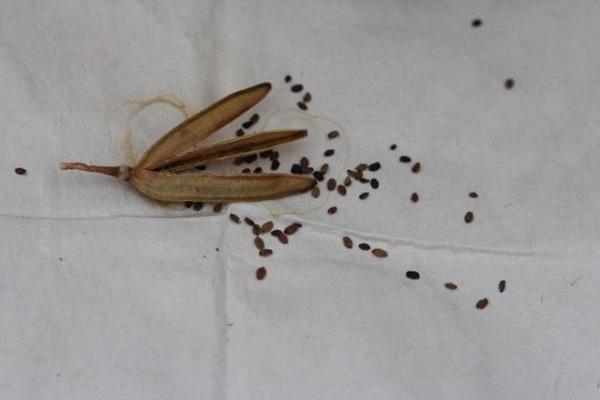

Reproduction of lilies by bulbs (buds)
The popularity of this method is due to the low trauma and lack of stress for the plant. This method is suitable for varieties that form a large number of buds in the leaf axils. Asian hybrids are vivid representatives of plants, on the aerial parts of the stem of which many air bulbs are formed every year. Their formation can usually be observed at the end of flowering. The ripening of the bulbs can be determined by the following features:
- the appearance of small roots (although they may not always appear);
- separation of the bulbs from the stem.
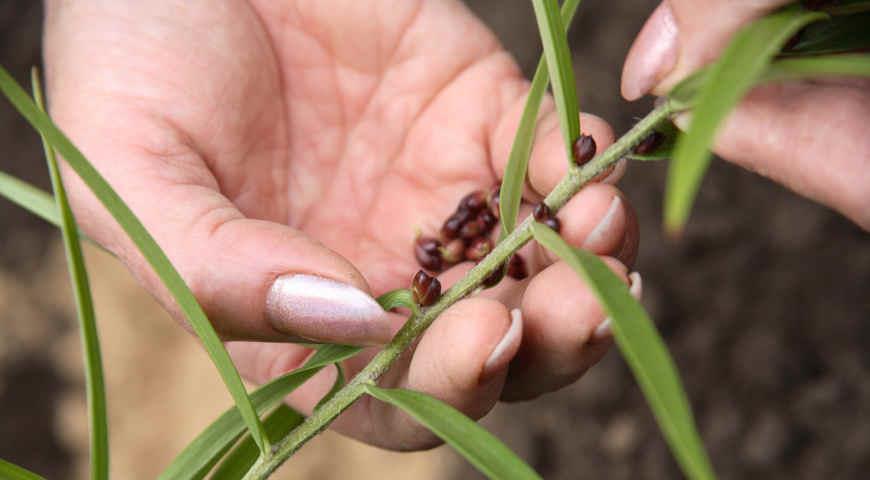

Collecting the formed buds should begin in August, until they crumble and germinate on their own.
After collecting, they are planted in the ground 2 cm deep, observing a distance of 15-20 cm between the holes. After planting, the soil must be watered, fertilized, and covered with dry foliage for the winter. The buds, intended for planting in spring, should be stored in a refrigerator at a temperature of +5 ° C, in a container with dry sand.
Plant shoots can be expected next spring. Follow-up care for lilies is standard: weed removal, top dressing and regular watering. The buds appear the next year, but it is better to cut them off. This is necessary so that the plant has time to fully grow stronger and form, and not waste energy on flowering.
Sometimes there are not as many buds on lilies as we would like. Therefore, there are several factors that stimulate their appearance:
- Increased soil moisture in summer (without water stagnation).
- Removing the first buds from a young plant. It is important to keep in mind that removing blooming flowers will have no effect.
- Regular feeding and loosening of the soil.
It will also be interesting: Lilies have faded - what to do next, caring for plants in August and September ⚜
Cutting lilies with a young flower shoot
Breeding lilies from young shoots is possible only at the beginning of the growing season:
- In the spring, after the emergence of shoots from the bulb, the young shoot is carefully separated when it reaches a height of 10-15 cm.
- Several longitudinal shallow cuts 2-3 cm long are made at the base of the shoot with a sharp knife and soaked for 1 hour in an epin solution.
- The shoot is planted in the ground, deepening by 5-7 cm, watered abundantly and covered with a cut plastic bottle, from the neck of which the lid must be removed. Thus, the plant finds itself in a kind of mini-greenhouse that maintains high humidity and heat, but the open hole on top allows the shoot to not overheat.
- After 2-3 weeks, when the roots begin to develop at the shoot, and bulbs form at the base, the bottle can be removed.
- Further care consists in regular watering and weeding. The bush will need to be spud higher so that more bulbs are formed.
- With the onset of the first frost, the shoot is dug up and young lily bulbs are carefully separated from it, the children are planted in open ground for growing.
In another year, it will be possible to plant young lilies in a permanent place.
Important! A knife or other tool that will be used for cutting and making cuts must be disinfected with alcohol so as not to introduce a fungal infection into the future flower and not to destroy the stalk.
Breeding with stem bulbs and cuttings
Bulb propagation is typical of Asian hybrids. On the stem of the flower, buds are formed, their size depends on the variety and the use of certain fertilizers. These air buds are larger in young specimens and in those flowers from which the buds have been removed. You need to collect the bulbs when the plant has faded. The collected material must be placed in a bag and sent to the refrigerator for 2 weeks. When the roots appear, it is required to plant the seedlings in open ground. At the same time, the soil where the air buds are planted should be soft and nutritious.
Planting is carried out to a depth of 2-3 cm and at a distance of 5-6 cm from neighboring ones. The next year, grown specimens can be planted in a flower garden. Lilies that are propagated in this way usually bloom in the 3rd year of their growth.
How to propagate lilies by cuttings? This method is suitable for valuable and rare varieties. For this method, take stems and leaves. Propagation of lilies by cuttings is carried out before the formation of buds. The stem must be divided into cuttings of 7-8 cm, planted immediately in open ground, while the plant is placed obliquely, deepening to the apical leaves. Immediately after planting, it is necessary to shade the seedlings. Care consists in abundant watering, after 30-50 days, small bulbs appear.
A leaf stalk is formed from a leaf and part of the stem, the procedure is carried out before flowering. Planting should first be carried out in boxes with nutritious soil, on top of the seedlings should be covered with foil. In order for the plant to take root, it is only necessary to slightly moisten the soil layer. After the plant takes root, it is planted in an open flower bed.
Lilies are quite delicate flowers, they require special care, so any manipulation with them must be done with care. If the gardener wants to get a flower garden of a significant size, then it is recommended to replant the lilies after each completed flowering.
Possible errors of florists
When using scales for lily propagation, it is very important to rinse the bulb well, and separate the scales as carefully as possible. The most productive are the large flakes from the outer layer. If it is necessary to preserve the mother bulb, more than 50% of the scales must not be removed. If the separation of scales is carried out in the spring, planting is carried out directly into the open ground.
Quite often, flower growers are faced with the difficulties of breeding lilies with bulbs. It should be remembered that the younger the lily, the more bulbs are formed. Also, a large amount of planting material is formed during prolonged rainy weather. To increase its number, experienced florists carry out decapitation, by means of which it is possible to cause the formation of bulbs even on some non-bulbous varieties of lilies.

